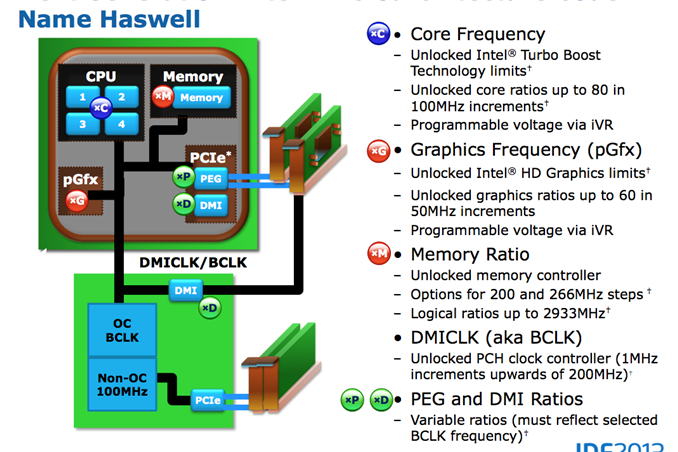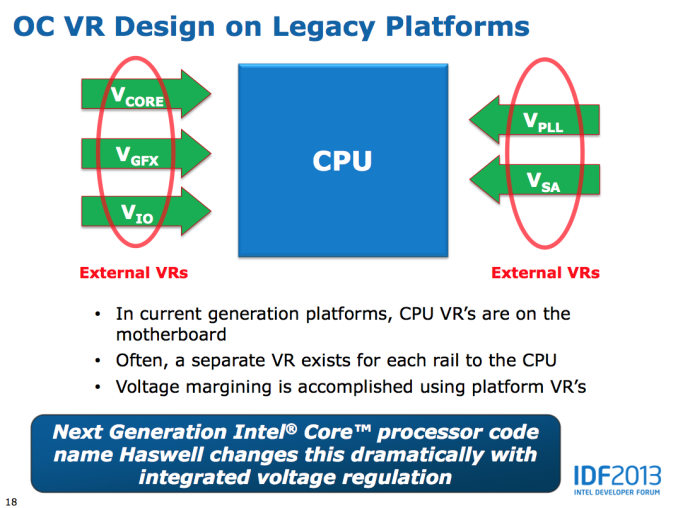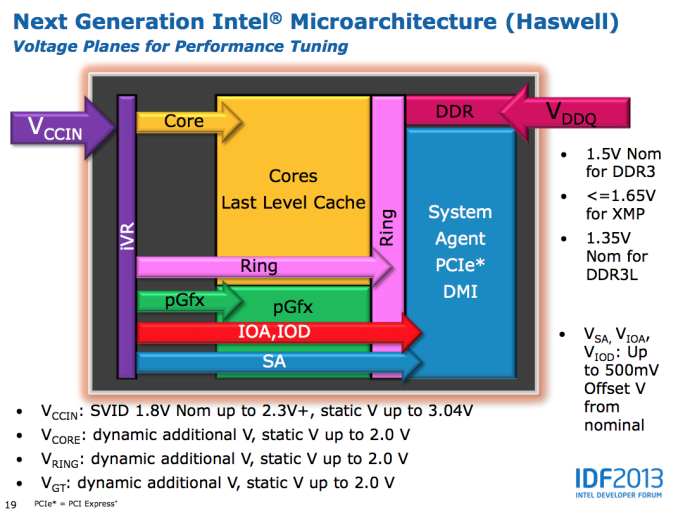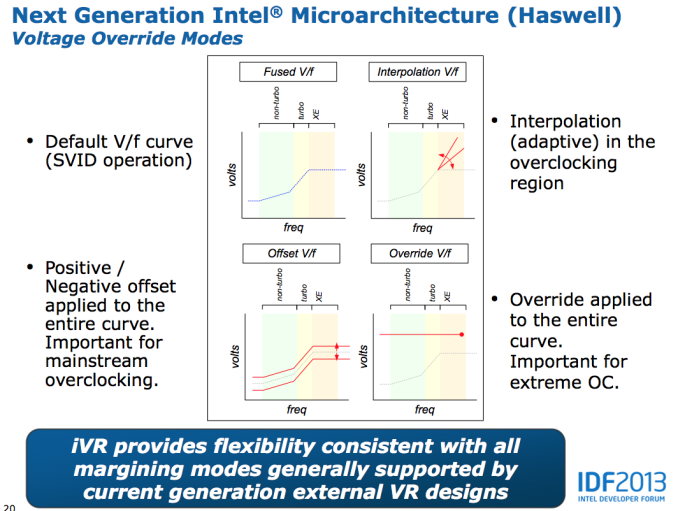Intel Details Haswell Overclocking at IDF Beijing
by Anand Lal Shimpi on April 12, 2013 5:19 PM EST
As we march towards the June 2nd release of Intel's Haswell processors, the company is slowly but surely filling in the missing blanks. Most recently we saw a shot of the often discussed but rarely seen Haswell GT3e part with on-package DRAM, and today we get some confirmation on what overclocking Haswell will be like.
As a quick refresher, the max clock frequency of Haswell is governed by the following equation:
Clock Speed = BCLK * Ratio
In the old days, both of the variables on the right hand side were unlocked (back then it wasn't called BCLK). Around the time of the Pentium II, Intel locked the multiplier ratios (rightmost variable) and then a few years ago we lost the ability to manipulate un-multiplied input frequency.
We can actually trace the recent struggles with BCLK overclocking back to the days of Lynnfield in 2009. Lynnfield featured Intel's first on-die PCIe controller, which wasn't fully decoupled from the rest of the CPU. We still had BCLK overclocking, but you needed to supply higher core voltages to the CPU to get there with any amount of stability. Nehalem, Lynnfield's predecessor, didn't have this issue.
With Sandy Bridge, we lost the ability to overclock using the BCLK altogether. Intel made good on this tradeoff by giving us a couple of K-series SKUs with unlocked multipliers, but it pretty much killed the market for buying low end Intel CPUs and overclocking them to deliver the performance of much higher end parts (sidenote: this is why we need AMD, ARM only pushes Intel to be more competitive on power at this point).
Ivy Bridge didn't really change things, but Sandy Bridge E did restore a bit of BCLK overclocking. You could select from a handful of predefined straps that enabled BCLK overclocking but without running the PCIe or QPI busses out of spec. With Haswell, we get something similar.
The default BCLK for Haswell parts will remain at 100MHz, however now you'll have the ability to select 125MHz or 167MHz as well. The higher BCLK points are selectable because they come with different dividers to keep PCIe and DMI frequencies in spec. At each of these BCLK settings (100/125/167MHz), the typical inflexbility from previous architectures remain. Intel's guidance is you'll only be able to adjust up/down by 5 - 7%.
Obviously we'll still have K-series SKUs with fully unlocked multipliers. Intel claims the CPU cores will have ratios of up to 80 (8GHz max without BCLK overclocking, although you'll need exotic cooling to get there). Some parts will also have unlocked GPU ratios, with a maximum of 60 (GPU clock = BCLK/2 * ratio, so 3GHz max GPU clock).
Memory overclocking is going to be very big with Haswell. Intel will offer support for 200MHz steps up to 2.6GHz and 266MHz steps up to 2.66GHz on memory frequency, with a maximum of 2.93GHz memory data rate supported.
Voltages are the other big change with Haswell. All Haswell SKUs will ship with an integrated voltage regulator. Instead of having multiple voltage rails driven by external voltage regulators enter the SoC, Haswell will accept two input voltages: Vccin for logic and Vddq for DRAM. Vccin should typically be somewhere in the 1.8V - 2.3V range, with a max of 3.04V. Vddq will depend on your DRAM type. The integrated voltage regulator will support all of the same adjustments than we're used to on current Ivy Bridge platforms.
What Intel isn't talking about publicly is just how overclockable Haswell is. I'm hearing great things about LN2 overclocking, but other than the high-end memory vendors being pleased with the new platform I haven't heard much on what will be possible on air. A much beefier GPU (at least on the high-end SKUs) and on-package voltage regulation will make for some very interesting thermal conditions.
Intel has been walking a fine line lately with giving the overclocking community enough to be relatively happy but not too much. The days of the Celeron 300A aren't coming back. Intel isn't a fan of giving things away for free and I wouldn't expect that to change now, especially given AMD's current competitive position.
















36 Comments
View All Comments
Hrel - Monday, April 15, 2013 - link
Damn, I'm still running Nvidia 650 sli with a Core 2 Duo E8400. Haha, use that desktop almost exclusively for watching tv shows and movies at this point though. Plugged into a tv with bluetooth keyboard/mouse. 4GB DDR2-800, GTX-460 768MB with a USB 3.0 add in card, a 256GB SSD and it's overclocked to 3.53Ghz. But I only overclock when I'm going to be rendering video or editing pictures on it. Old girl has held up well over the years, Asus motherboard is fantastic. Certainly seen it's fair share of upgrades. Originally had a Celeron, then Pentium 4 HT, then Pentium D 830 I believe, then Core 2 Duo E6600, finally the E8400. GPU's, X1650XT, or something, 256MB vRAM.. Then 8800GT, 512MB GDDR3. Then money got tight so sold that and got HD4670 512MB DDR3. Then finally the upgrade to GTX460 768MB. You're comment made me get all nostalgic, sorry for carrying on.stickmansam - Friday, April 12, 2013 - link
Will be interesting to see if they will return to solder to help cool the extra heat from more things on the die. The 22nm process maturity should help too.The bclk likely won't change max stable OC too much except for providing more flexibility
Hubb1e - Friday, April 12, 2013 - link
So this means the return of i3 overclocking. AMD had better really step up their game or really hope that game developers produce ports that require lots of cores.A5 - Friday, April 12, 2013 - link
Indeed. The i3s are unlocked downwards, right? You could do a 167 BCLK x 27 Ratio to get a 4.5GHz overclock with a good chip and the right cooling.stickmansam - Saturday, April 13, 2013 - link
BCLK may be locked on lower level chips or in the chipset, we shall seeepobirs - Monday, April 15, 2013 - link
With the next generation of consoles pushing multi-core, it seems likely the PC versions of games will follow suit.Navier - Friday, April 12, 2013 - link
If this is true: "The default BCLK for Haswell parts will remain at 100MHz, however now you'll have the ability to select 125MHz or 167MHz as well."Then with good air/radiator cooling could a 25% OC may be posible with i7 4770?
Or maybe a i7 4770S with lower base clock + BLCK overclock to 125MHz may be a very interesting performer, and still have all the features (VT-d and TXT) without buy a "K" (feature Killer) model.
MrSpadge - Saturday, April 13, 2013 - link
THe multiplier is unlocked downwards anyway, so no need to go for a S model.HardwareDufus - Saturday, April 13, 2013 - link
I hope they reverse their decision not to include GT3 for the Desktop Variants of the CPU. I still enjoy building mITXmachines with decent video performance without adding a discreet card. At the moment, I enjoy my I7-3770K @ 4Ghz in my mITX machine. But I need to build a 2nd machine... so I hope the I7-4770K will be available with GT3, though I have heard it will not..sherlockwing - Saturday, April 13, 2013 - link
You can get desktop chips i5 or i7 with GT3e, however those are the R SKU BGA modeals. You should be able to get MITX models with those soldered on. But it is unlikely for Intel to offer 4770K with that GPU since most CPU overclockers would have no use for GT3e in their system.